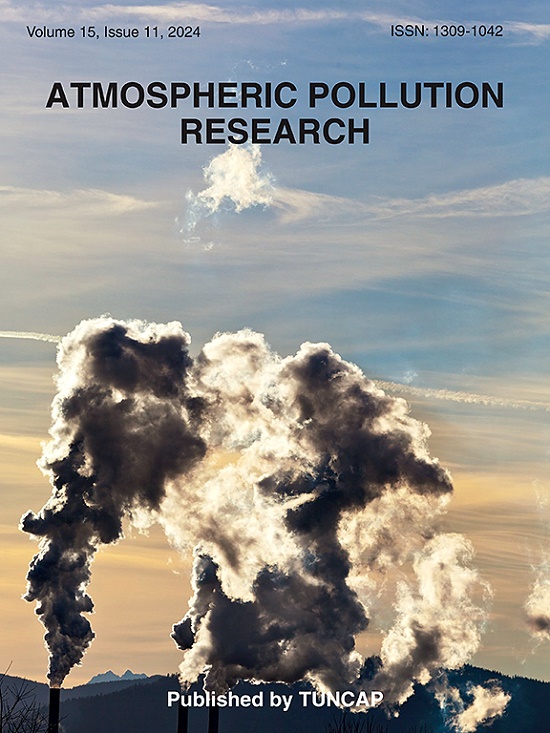Understanding the physicochemical characteristics of PM2.5 under meteorological influence: A study in South Chungcheong Province, South Korea (2021–2022)
IF 3.9
3区 环境科学与生态学
Q2 ENVIRONMENTAL SCIENCES
引用次数: 0
Abstract
Despite the implementation of various policies worldwide to reduce PM2.5 concentrations, they have remained sufficiently high and cause serious environmental and health problems. Most studies and policies regarding PM2.5 in South Korea have primarily focused on the Seoul Metropolitan Area, including Seoul, and there is a lack of research data necessary for implementing PM2.5 management policies in South Chungcheong Province (SCP). In this study, we used data from the Air Quality Research Center in Seosan, SCP, to conduct a detailed analysis of PM2.5, focusing on its chemical and physical properties as well as the influence of meteorological factors on PM2.5 characteristics. The mean PM2.5 concentrations were 16.7 ± 12.5 μg/m3 in the warm season and 31.1 ± 18.7 μg/m3 in the cold season, showing a twofold increase in the cold season. The ratio of NO3− in the chemical composition of PM2.5 was higher in the cold season (19%) compared to the warm season (15%), while SO42− was 1.75 times higher in the warm season. Using the atmospheric oxidant (Ox) and analyzing PM2.5 concentrations under different photochemical conditions, we found that small particles dominated in the warm season, shifting towards smaller particle sizes in the size distribution with higher temperatures due to secondary particle production. In contrast, higher concentrations of PM2.5 during the cold season were attributed to direct emissions and external influx. Our findings highlight the importance of managing small particles in summer and provide valuable data for South Chungcheong Province, aiding future policy development to reduce PM2.5 levels.
气象影响下PM2.5的理化特征——以韩国忠清南道2021-2022年为例
尽管世界各地实施了各种降低PM2.5浓度的政策,但PM2.5浓度仍然很高,造成了严重的环境和健康问题。国内有关PM2.5的研究和政策主要集中在首尔等首都圈,在忠清南道(SCP)实施PM2.5管理政策所需的研究资料不足。在本研究中,我们使用SCP Seosan空气质量研究中心的数据,对PM2.5进行了详细的分析,重点关注其化学和物理性质以及气象因素对PM2.5特征的影响。暖季PM2.5平均浓度为16.7±12.5 μg/m3,冷季为31.1±18.7 μg/m3,呈2倍增长。冷季PM2.5化学成分中NO3−的比例(19%)高于暖季(15%),而SO42−的比例是暖季的1.75倍。利用大气氧化剂(Ox)和不同光化学条件下的PM2.5浓度分析,我们发现暖季以小颗粒为主,随着温度的升高,由于二次颗粒的产生,粒径分布向小颗粒转移。相比之下,寒冷季节PM2.5浓度较高归因于直接排放和外部流入。我们的研究结果强调了夏季管理小颗粒的重要性,并为忠清南道提供了有价值的数据,有助于未来制定降低PM2.5水平的政策。
本文章由计算机程序翻译,如有差异,请以英文原文为准。
求助全文
约1分钟内获得全文
求助全文
来源期刊

Atmospheric Pollution Research
ENVIRONMENTAL SCIENCES-
CiteScore
8.30
自引率
6.70%
发文量
256
审稿时长
36 days
期刊介绍:
Atmospheric Pollution Research (APR) is an international journal designed for the publication of articles on air pollution. Papers should present novel experimental results, theory and modeling of air pollution on local, regional, or global scales. Areas covered are research on inorganic, organic, and persistent organic air pollutants, air quality monitoring, air quality management, atmospheric dispersion and transport, air-surface (soil, water, and vegetation) exchange of pollutants, dry and wet deposition, indoor air quality, exposure assessment, health effects, satellite measurements, natural emissions, atmospheric chemistry, greenhouse gases, and effects on climate change.
 求助内容:
求助内容: 应助结果提醒方式:
应助结果提醒方式:


